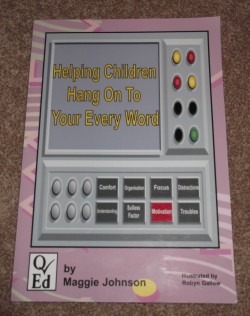Attention and listening is a big issue for many children with language problems and one which can affect them hugely in the classroom. It can also get them into trouble in school sometimes if the difficulty means that they find it hard to sit still or can’t stop calling out. Sometimes it can be one of those chicken and egg questions when trying to work out what’s causing the problem with a child – are they not listening because they don’t understand or are they not understanding because they’re not listening?
As a speech and language therapist, I’m often asked to give advice about attention and listening and, if I’m honest, that’s sometimes hard. There are so many variables involved and often I have only seen the child once or twice, maybe in a 1:1 setting, and so it can be quite difficult to give really specific advice about how to help that particular child in the classroom.
I have recently found this book however, and it has really helped me to think through the tricky problem of attention and listening difficulties.
“Helping kids hang onto your every word” is a very practical resource manual, well laid out and with a very clear structure that makes it easy to find the bit you’re looking for if you want to copy it to give it out to a parent or school. In the introduction, Maggie Johnson talks about all the different variables which affect attention and listening and explores them a little. These are:-
- Comfort – is the child on an uncomfortable chair? Or are they hungry? Or is it too hot?
- Focus – is the child able to give and sustain focus?
- Distractions – are there too many things going on in the room? Or a constant noise in the background?
- Troubles – is the child worried about something?
- Organisation – does the child know how long this task will last? And what will happen next? It may affect their listening if they don’t.
- Understanding – Does the child understand what is being said? We all switch off if a task is too hard or we don’t know what we’re expected to do.
- Motivation – does the child want to do the activity? (There is a warning about just saying a child can’t do it just because they don’t want to, as very often it is far more complex than that)
- SuXess Factor – is the child used to succeeding because tasks are pitched at the right level for them? This will affect their ability to persist.
There are various charts and advice to help you think through which of these elements may be affecting the child that you’re working with. Then there’s a 4-6 page section on each one, all in bullet points, packed full of advice. Each section is split up into signs that this is an area of difficulty for a child, what may be causing the difficulty and how to help. There are suggestions of other resources and reading at the end of each section.
As if that wasn’t enough, at the end of the book are extra advice sheets on topics such as active listening (she also has a whole programme on this here which is also brilliant!) developmental norms for attention and listening and play, graphic organisers and timelines to support understanding and break tasks down, phonological awareness, selective mutism and lots of other things.
It’s a great book, published by QEd and available direct from them or here for £10.
What other resources do you use to support attention and listening? Do let us know.







Leave a Reply